A bit of context, I am participating in the UK CanSat competition. I am sorting out the communication between the CanSat and the ground station. We are using LoRa transceivers as required per the competition. We are using a raspberry pi pico as a emitter and an Arduino nano in the ground station as a receiver. The LoRa module we are using is this one.
Long story short, when I receive the message in the ground station, there are multiple symbols, here is a picture:
Here is the code for the Arduino (receiver):
// Arduino9x_RX
// -*- mode: C++ -*-
// Example sketch showing how to create a simple messaging client (receiver)
// with the RH_RF95 class. RH_RF95 class does not provide for addressing or
// reliability, so you should only use RH_RF95 if you do not need the higher
// level messaging abilities.
// It is designed to work with the other example Arduino9x_TX
#include <SPI.h>
#include <RH_RF95.h>
#define RFM95_CS 10
#define RFM95_RST 9
#define RFM95_INT 2
// Change to .0 or other frequency, must match RX's freq!
#define RF95_FREQ 433.0
// Singleton instance of the radio driver
RH_RF95 rf95(RFM95_CS, RFM95_INT);
// Blinky on receipt
#define LED 13
void setup() {
pinMode(LED, OUTPUT);
pinMode(RFM95_RST, OUTPUT);
digitalWrite(RFM95_RST, HIGH);
while (!Serial);
Serial.begin(9600);
delay(100);
Serial.println("Arduino LoRa RX Test!");
// manual reset
digitalWrite(RFM95_RST, LOW);
delay(10);
digitalWrite(RFM95_RST, HIGH);
delay(10);
while (!rf95.init()) {
Serial.println("LoRa radio init failed");
while (1);
}
Serial.println("LoRa radio init OK!");
// Defaults after init are 434.0MHz, modulation GFSK_Rb250Fd250, +13dbM
if (!rf95.setFrequency(RF95_FREQ)) {
Serial.println("setFrequency failed");
while (1);
}
Serial.print("Set Freq to: "); Serial.println(RF95_FREQ);
// Defaults after init are 434.0MHz, 13dBm, Bw = 125 kHz, Cr = 4/5, Sf = 128chips/symbol, CRC on
// The default transmitter power is 13dBm, using PA_BOOST.
// If you are using RFM95/96/97/98 modules which uses the PA_BOOST transmitter pin, then
// you can set transmitter powers from 5 to 23 dBm:
rf95.setTxPower(23, false);
}
void loop() {
if (rf95.available()) {
// Should be a message for us now
uint8_t buf[RH_RF95_MAX_MESSAGE_LEN];
//char buf = (char*)buf;
uint8_t len = sizeof(buf);
if (rf95.recv(buf, &len)) {
digitalWrite(LED, HIGH);
Serial.print("Got: ");
Serial.println((char*)buf);
Serial.print("RSSI: ");
Serial.println(rf95.lastRssi(), DEC);
} else {
return;
}
}
}
Disclaimer this code was extracted from the internet.
And here is the code for the Raspberry pi pico (emitter):
import board
import busio
import time
import digitalio
import adafruit_rfm9x
import adafruit_bmp280
"Led configuration"
# Led amarillo
ledambar = digitalio.DigitalInOut(board.GP16)
ledambar.direction = digitalio.Direction.OUTPUT
# Led azul
ledazul = digitalio.DigitalInOut(board.GP17)
ledazul.direction = digitalio.Direction.OUTPUT
"LoRa"
# LoRa radio setup
spi = busio.SPI(clock=board.GP2, MOSI=board.GP3, MISO=board.GP4)
cs = digitalio.DigitalInOut(board.GP6)
reset = digitalio.DigitalInOut(board.GP7)
rfm9x = adafruit_rfm9x.RFM9x(spi, cs, reset, 433.0)
print("RFM9x radio ready")
"Not LoRa from here"
"BMP280 Sensor"
# BMP280 comunication start up
i2c = busio.I2C(scl=board.GP15, sda=board.GP14)
bmp280_sensor = adafruit_bmp280.Adafruit_BMP280_I2C(i2c, address=0x76)
# BMP280 sensor readings
def read_temperature():
return bmp280_sensor.temperature
def read_pressure():
return bmp280_sensor.pressure
while True:
ledazul.value = True
"LoRa"
rfm9x.send("Hello World, this is a test, why does this not work? im going mad!!!!")
print("Radio mensage sent")
"Not LoRa from here"
ledazul.value = False
cansat_temperature = read_temperature()
print("TEMPERATURE:")
print(cansat_temperature)
cansat_pressure = read_pressure()
print("PRESSURE:")
print(cansat_pressure)
print(" ")
time.sleep(2.5)
Disclaimer, this code is designed to do more things than just LoRa communication. The LoRa part of the code is below the tag: "LoRa".
If you have any recommendations on how to improve my code in any way, just let me know, it would be really helpful.
Thank you.
I have tried soldering the antennas, changing them, modifying the code, both in the pico and the Arduino, also tried changing the antennas but nothing worked.
